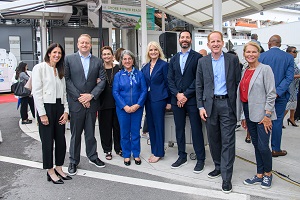Shore Power Program
Miami-Dade County's Shore Power Program is a partnership between PortMiami, its cruise partners Carnival Corporation, MSC Cruises, Norwegian Cruise Line Holdings, Royal Caribbean Group, and Virgin Voyages and Florida Power & Light Company.
Shore power allows a cruise ship, which uses as much electricity as a small city, to turn off their engines and plug into landside electrical power, while docked at PortMiami. When ships are berthed, they need electricity for lights, refrigeration, operating equipment and other vessel functions.
PortMiami is the first major cruise port on the U.S. eastern seaboard to construct shore power capability at five cruise berths:
- Cruise Terminal AA, MSC Cruises
- Cruise Terminal A, Royal Caribbean International
- Cruise Terminal B, Norwegian Cruise Line
- Cruise Terminal F, Carnival Cruise Line
- Cruise Terminal V, Virgin Voyages
Mayor’s Shore Power Initiative
Shore Power Details
Plugging into shoreside electricity allows cruise ship engines to be switched off, reducing emissions by up to 98%.
On any given day, PortMiami can plug in three ships safely and simultaneously.
The annual emission reduction estimate associated with the connection to shore power at one terminal is equivalent to the emission reduction associated with the removal of 7,500 cars from the road, according to the Moffat and Nichol analysis of reduced GHG emissions when the vessels are plugged in at PortMiami.
PortMiami is one of 35 seaports around the world to offer at least one cruise berth with shore power. This represents about 2% of the total number of cruise ports globally.
Cost and Funding
Miami-Dade County's Shore Power Program cost an estimated $125 million ($25 million per terminal).
PortMiami received $21.7 million in grants for shore power, including $19.7 million from Florida Department of Transportation and $2 million from U.S. Environmental Protection Agency.

